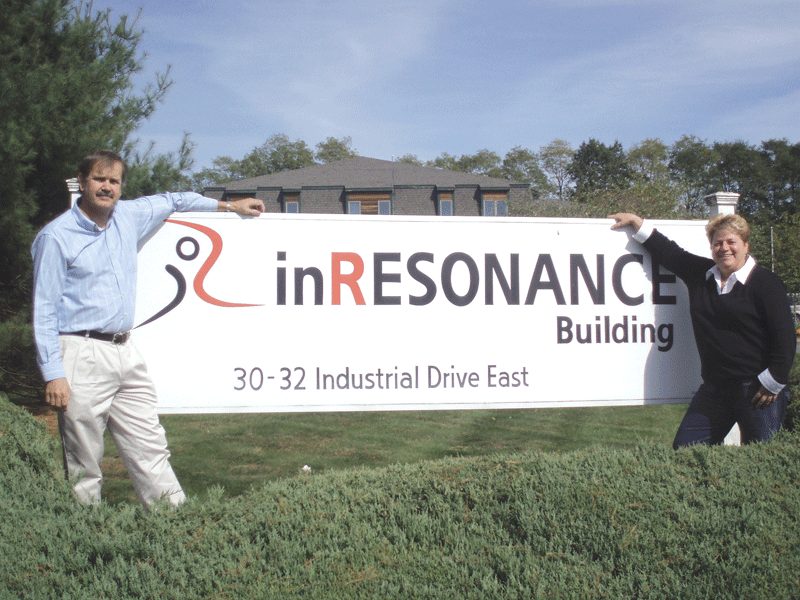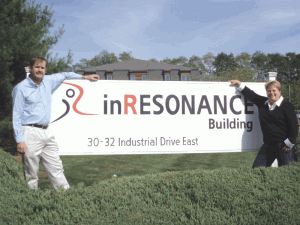
Life Lessons
This Software Company Has Several New Schools of Thought

inResonance President and CEO Kevin McAllister and Vice President of Global Sales Marlene Marrocco say the company provides software to more than 275 private and charter schools, including American schools in Tokyo, Geneva, Singapore, London, Paris, and Amsterdam.
He spent 17 years as a Geology and Spanish teacher at Loomis Chaffee School in Windsor, Conn., where he witnessed the nightmare of paperwork that everyone working there had to deal with.
“As a teacher, I had to send reports to parents six times a year. They had to be produced in triplicate through photocopying, then they were stapled together and mailed out,” he said. “I wanted to solve the problem, so I built a very primitive software system to make sending comments to parents easier.”
That was in 1992, and this system, which was expanded to include admissions, worked so well that word about it spread quickly. McAllister began running a sole proprietorship called KJM Consulting, and within a few years, 50 private schools were using his software.
By 1999, he had clients overseas as well as in the U.S. He had served on state and regional IT boards, had contracts as a consultant with schools, and had spoken at conferences across the country. What had started as a small side business was now starting to dominate McAllister’s time and his dreams for the future.
“My two daughters were graduating from high school, and I decided to take the jump,” he said, meaning that he had decided to give up teaching and start a business, one he would call inResonance Inc.
Today, the Northampton-based company provides database solutions and related Web applications that include fund-raising and constituent management, admissions and enrollment, and registrar functions to more than 275 private and charter schools, including American schools in Tokyo, Geneva, Singapore, London, Paris, and Amsterdam.
McAllister’s wife, Susan, is director of client services at inResonance, and together they share a passion for helping others and making a difference, which stemmed from time they spent as Peace Corps volunteers. “Susan was a math teacher in Africa, and I was a university professor in Paraguay. Watching inefficiency drove us to look for solutions,” McAllister said.
The name of their company is a reflection of his mission — to keep everything in tune by providing people with the tools they need to be efficient. “The people we work with are intelligent, dedicated professionals, but they don’t necessarily know the most efficient way to do their jobs,” he said, adding that everyone in an organization should be in resonance with each other. “You want everyone tuned up, singing the same tune, because the business process is only as efficient as the people working together.”
Problem Solving
McAllister says one of the problems private schools face is processing applications. He explained that schools can have several thousand applicants a year and need to rank them as well as keep on top of the process, which includes details such as whether they have received a student’s grades, transcripts, birth certificate, recommendations, photo, and other requirements, such as interviews conducted when the student and parents visit the school.
“It’s a long and complex process because the typical prep schools funnels 3,000 inquiries, which turn into 1,200 applications. They may accept 250 students, but only 125 of them decide to go there because they have also applied to other schools,” McAllister explained. “Then you have to throw in the financial-aid component, which makes it very difficult to fill 125 spots.”
However, admissions is the most critical office in many private schools because 85% to 90% of their income is dependent on it, McAllister said, adding that the remainder typically comes from endowments.
“Schools purchase our admissions systems to provide online applications and to process them in an efficient way, which can save them hundreds of man hours a year. Every school has a customized application, and it’s a complete transformation of the process. What used to take employees hours and hours to process now takes minutes.”
Another of inResonance’s mainstay products is used by registrars’ offices, where challenges include scheduling classes, grading, attendance, and teacher’s reports. The inResonance software system allows parents to go online and see their children’s grades and records, which McAllister considers critical to success.
Everyone who works at inResonance has a background in education. “We are not a bunch of programmers. We are efficiency experts who bring technology tools to the table. That’s our ethos — to empower dedicated professionals,” McAllister said. “We don’t want to work with organizations that don’t want to change. We want to work with people who are doers and innovators. We expect to be in conversation with our clients for many years as part of their strategic planning.”
McAllister said the company’s systems are not built for large public-school systems with rigid rules and that cannot afford variations. “The important word for us is independent. Our schools may run different classes every six weeks and do interesting things educationally, which we can accommodate. We don’t have a cookie-cutter system,” he explained, adding that charter schools are a growing segment of their clientele.
The company’s software also solves problems inherent to lottery systems used to determine which students are chosen to attend a school. “Before this software, people were literally picking cards out of a bowl,” McAllister said.
One of the many benefits of the company’s software is that it can be adapted to suit different needs. “We don’t build a custom solution for every school, but have a solid core that can be customized. Because we are small, nimble, and flexible, we are involved with a lot of factors and can serve a variety of educational innovations,” he said.
Another product, called Generations, helps schools with fund-raising. “It keeps track of constituents, parents, grandparents, trustees, and all their giving by allowing the school to run statistics. It also generates annual reports, including all activities and fund-raisers,” McAllister said. “The product was developed about six years ago and has allowed us to really move into radically different markets.”
Three years ago, the company began working on a new initiative called NodeLinks, with the aim of helping the nonprofit sector. McAllister hopes to launch it soon, and says the basic concept involves connecting clusters of nonprofits into nodes or groups who join and share their resources to generate success.
“We believe that, because of their limited budgets, they need to work together to become efficient,” he said. “We would like to create nodes in every city and link them together.”
Each node would be made up of 10 organizations with partners that include consultants, students, philanthrophists, volunteers, the Web community, and community developers. They would each pay one-tenth of the salary of a shared employee who would help them realize common goals using technology.
“There are 700,000 nonprofits competing for funds, and we believe there is opportunity and possibility for them to work together so they could provide a common front to funders and write more realistic grant proposals,” McAllister said. “We want to pilot this in the Pioneer Valley and are looking for nonprofits and funding agencies to participate.”
Textbook Examples
NodeLinks will be a separate division of inResonance and will satisfy the McAllisters’ desire to help others just as they did when they were Peace Corps volunteers.
“My journey has been very circuitous,” said Kevin. “We have come full circle in what we have learned about making schools and nonprofits efficient. Susan and I both have a common ethos that came out of education and nonprofits. NodeLinks will allow us to come full circle with our passion and love, which is the nonprofit sector.”
If all goes as planned, the two will be adding yet another way for people to accomplish goals without frustration, he continued. “We are creating a structure to link people together so they can also work together in an efficient way.”




